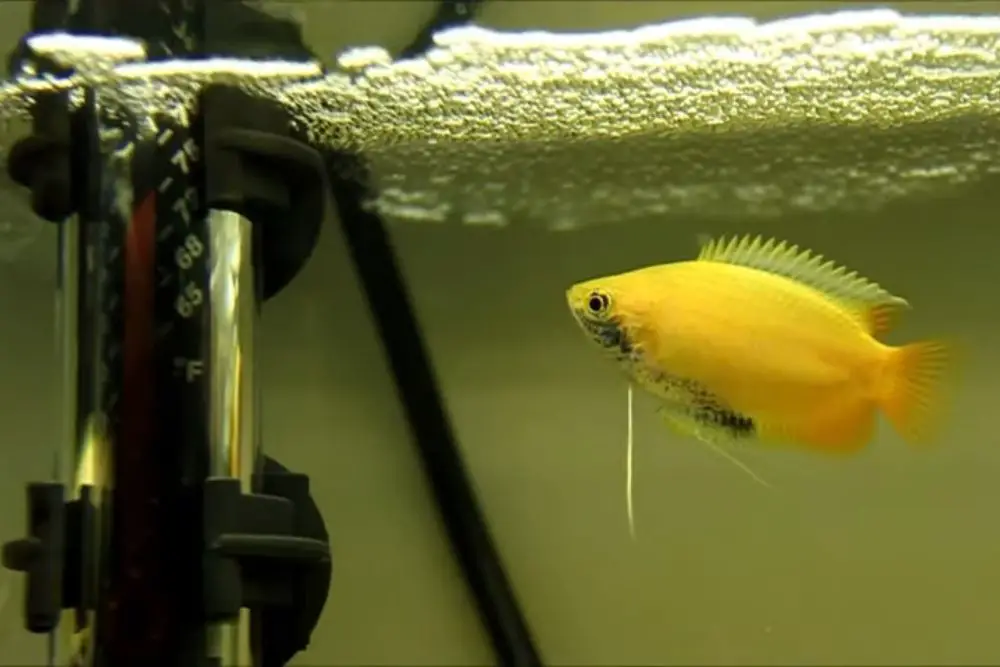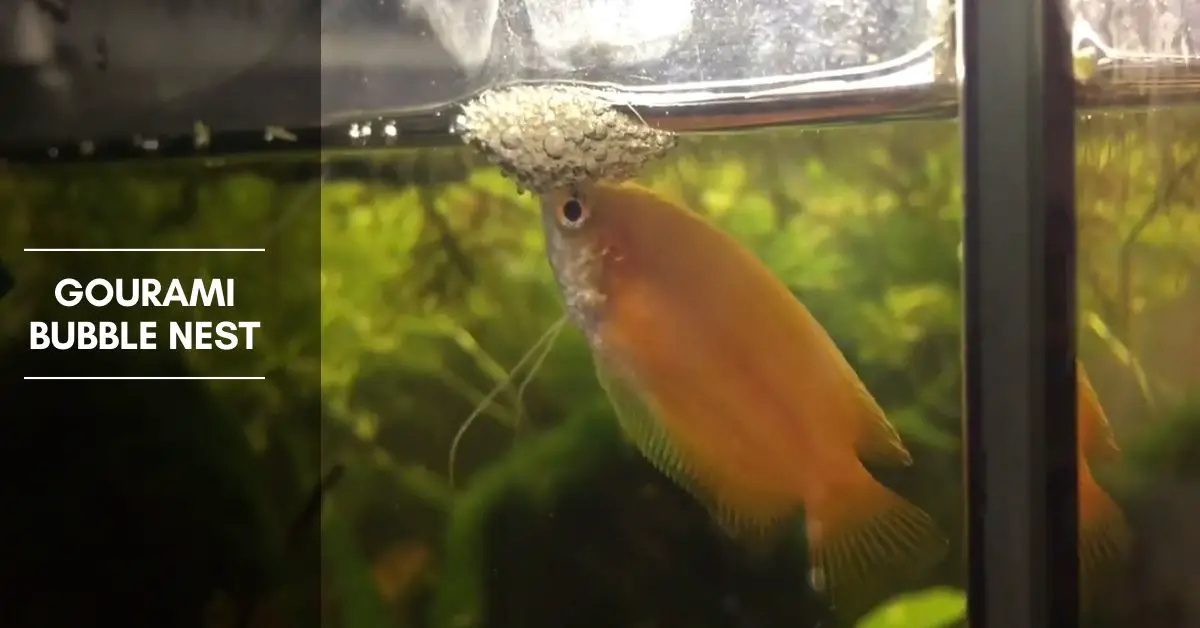Gouramis have evolved several different breeding strategies. Some species lay their eggs and move on with no care for the young. Other species build nests out of bubbles on the surface (some species’ eggs float; other species’ eggs sink), other species produce hidden, submerged bubble nests, and still, others are themselves nests, carrying their eggs and larvae in their mouths. Predictably, there is no one strategy for breeding Gouramis.
Egg Scatterers
The best-known Asian egg scatterer is the Kissing Gourami. Both eggs and larvae have oil globules, allowing them to float on the surface. The parent fish spawn and pay no further attention to the results. The aquarist can either remove all the adult fish in the tank, or collect the eggs for incubation.
Surface Bubble Nests
Surface bubble nests produce a foamy air, saliva, and sometimes plant-based floating nest at the surface. Betta and pseudosphromenus species produce sinking eggs, while Gourami (Colisa, Trichogastcr, and Macropodus) eggs float.
The nest is guarded until the fry are free-swimming. Usually, it is best to spawn these fish in special tanks, set up as smaller versions of the recommended maintenance tank. Removing the parent fish is always easier than trying to catch the tiny, delicate fry.
Hidden Bubble Nests
Hidden bubble nests can meet their oxygen needs through the use of their gills, and can, therefore, stay almost permanently submerged. Their bubble nests are constructed under overhanging leaves or on the roofs of caves. They tend to be small and shy. Examples are the Croaking and Licorice Gouramis.
Breeding
Many hobbyists don’t realize many Anabantoids mouthbrood. These Gouramis and Bettas tend to come from moving water that would destroy bubble nests. They are difficult to breed, as the male (who cares for the eggs and larvae) tends to swallow his charges when stressed.
These species can be bred in lightly and carefully stocked community setups. It is unwise to remove the male, as this often provokes immediate swallowing of the eggs or larvae. A good strategy is to remove all other fish and watch closely for fry.
You will not find many, as, compared to often-elaborate bubble nests, mouths hold very few eggs. Many Bettas, plus the Chocolate Gourami group, are the best known of the mouthbrooding species.
Feeding The Fry
Many Anabantoid fry are too small to eat the standard fare for newborns in the fish hobby, freshly hatched brine shrimp. They must be supplied with microorganisms. The inability of hobbyists to provide adequate quantities of food is the single greatest killer of Gourami and Betta fry.
Solutions involve some work. Starter cultures for microorganisms can be purchased online. Older aquarium sources have a variety of recipes based on turnips, boiled grass, and other vegetable matter combined with pond water that are just as useful, but more work.
If you are near an aquarium club, you can learn what is available locally. Otherwise, try the Internet. As a spin-off from the aquaculture industry, there are now some very small powdered foods. Combined with water and shaken vigorously, they provide a good start.
Spawning
Popular Gouramis like Trichogastcr, Colisa, and Macropodus often will readily spawn in community tanks; the challenge for the aquarist is raising the fry. Convincing the more difficult species to breed becomes an interesting challenge to many fish keepers.
Breeding Gourami Methods
- Fish can become distracted or stressed in an aquarium. Crowding, noisy, and vibrating equipment, aggressive tank mates, and other stresses will sometimes drive fish into “displaced behavior,” and possibly cause misdirected energy.
- Many of the tiny hidden bubble nesters can’t cope with other fish of even their own species in close proximity at breeding time. Try isolating a pair and see what happens.
- Turn off the lights, leave them in peace, and hope.
- Water conditions can be modified in a small breeding tank by adding clean rainwater or reverse osmosis water. Peat filtration can release stimulating tannins, as well as soften and darken water for blackwater species. In regions with iron-poor water, a dose of aquatic plant fertilizer sometimes jump-starts reproductive behavior.
- Many fish spawn at the onset of the rainy season. Aquarists will carefully slow down water changes, then suddenly do a large change with slightly cooler, softer water to mimic natural conditions. Most fish breeding secrets are simply the result of becoming informed and willing to experiment. Luckily, fish breeding experiments are usually fun.
Common Species of Gouramis
Dwarf Gourami
The Dwarf Gourami is a small fish. They occur in the wild with their cousins Honey Gourami and Banded Gourami in the wide delta of the Brahmaputra and Ganges Rivers in Bangladesh and into Borneo.
They grow to a maximum size of 2 inches (5 cm). For their length, they have stocky, heavy, high-backed bodies. The fact they come from ponds, irrigation systems, and slow-moving streams in a heavily populated and farmed region does not mean they are tolerant of pollution.
However, their labyrinth organ allows them to survive in low-oxygen situations. In the aquarium, they like warm water high 70s°F (mid-20s°C). The water must be clean. Otherwise, they are prone to bacterial or parasitic infections.
They will prosper in most water as long as it is not extremely hard or alkaline. They do best in planted tanks, especially with floating plants. Tank mates should be peaceful, as these fish hide when stressed. They are easily bullied or startled by fast-moving tank mates.
Males are colorful with a sharp point at the rear tip of the dorsal fin. Females are silvery with rounded dorsals. Male Dwarf gourami build complicated bubble nests, often incorporating floating plants into the structure.
A shallow aquarium, 4 to 6 inches (10 to 15 cm) deep with a submersible heater, a tight cover, and no fish other than the Dwarf Gouramis works best. A male with a nest will then court a female. If she is ready, spawning can take a couple of hours.
In typical Gourami fashion, the male will wrap around the female, who will expel several floating eggs. The male collects the eggs, puts them into the nest, and the process begins again. When the female is depleted, the male cares for the nest alone.
The female can be removed. Embryos hatch at 12 to 16 hours, although it will take two and one-half to three days for them to be able to swim. The male should then be removed. The keeper should commence feeding with commercial fry food or microorganisms.
In spite of their wide availability in the hobby, these are not always easy fish. Many of the animals sold in pet shops are suffering from poor treatment at the fish farm or in shipping. Healthy Dwarf gourami is easy fish to keep but is increasingly hard for hobbyists to find. So too are natural-looking Dwarf gourami.
Although the wild form is the most beautiful, a number of selected forms are being produced on fish farms. In some cases, the red predominates (and the blue of the wild fish is lost) or vice versa. The initial interest in these artificially selected forms caused them to be produced in enormous numbers, to the point where the natural-form fish is difficult to locate in some areas.
As well, females of the mutant forms seem rare in the shops, a fact that has led to speculation about fish farms using hormones to produce more colorful (and marketable) male fish. Stick to the beautiful wild form, and you will know what you are getting!
Honey Gourami

The Honey Gourami is 2-inch (5-cm) fish. Its range is narrower, mainly centered around Bangladesh.
Males are reddish-brown, deerskin-colored fish with bright yellow dorsals and a deep black mask that runs from the eyes to the base of the anal fin. Females are silvery with a generally light-colored longitudinal stripe.
The first complication with the fish, and the one that has kept it from the popularity it deserves, is its reaction to stress. In a bare aquarium store tank, males can entirely lose their colors, becoming indistinguishable from females. This not only makes choosing pairs difficult but also leaves the uninformed aquarist with the impression of looking at a tank of ugly, plain Gouramis.
If a group is bought and put into a peaceful tank with lots of floating plants, healthy males will become absolutely stunning fish within minutes. As long as they are happy, they will maintain their intense and spectacular coloration.
In fact, in a tank with small fish, Honey Gourami will rapidly take a dominant role, with vividly marked males parading along the front and even pecking at the glass when their keepers approach. In a large tank, male-only groups will form schools, all carrying full color.
Interestingly, in such a situation, when a male leaves the school, he will often leave his colors with it. They are interesting to breed, using the same techniques as detailed for Dwarf gourami, although they seem to handle slightly deeper water better.
In a single-species tank, or with small, nonpredatory tank mates in a lightly stocked, heavily planted aquarium, small numbers of babies will grow to adulthood with their parents. Both mutant and artificially colored versions of Honey Gourami are on the market. However, they are not as dominant in the pet trade as are mutant Dwarf gourami.
Honey Gourami is a fish that must be sought out. Often, the best way is to order it from a retailer. Many wholesalers keep inexpensive specimens on hand for connoisseurs, but shops will shy away from displaying them due to their gray stress coloration.

Hi, my name is Sean, and I’m the primary writer on the site. I’m blogging mostly about freshwater and saltwater aquariums, fish, invertebrates, and plants. I’m experienced in the fishkeeping hobby for many years. Over the years I have kept many tanks, and have recently begun getting more serious in wanting to become a professional aquarist. All my knowledge comes from experience and reading forums and a lot of informative sites. In pursuit of becoming a professional, I also want to inspire as many people as I can to pick up this hobby and keep the public interest growing.
Read more about Sean.
Please join also my Facebook group.


2 thoughts on “Gourami Bubble Nest – Breeding, and Common Gourami Species”
Comments are closed.